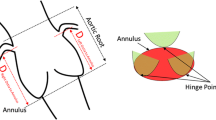Abstract
Transcatheter aortic valve implantation is a minimal-invasive intervention for implanting prosthetic valves in patients with aortic stenosis. Accurate automated sizing for planning and patient selection is expected to reduce adverse effects such as paravalvular leakage and stroke. Segmentation of the aortic root in CTA is pivotal to enable automated sizing and planning. We present a fully automated segmentation algorithm to extract the aortic root from CTA volumes consisting of a number of steps: first, the volume of interest is automatically detected, and the centerline through the ascending aorta and aortic root centerline are determined. Subsequently, high intensities due to calcifications are masked. Next, the aortic root is represented in cylindrical coordinates. Finally, the aortic root is segmented using 3D normalized cuts. The method was validated against manual delineations by calculating Dice coefficients and average distance error in 20 patients. The method successfully segmented the aortic root in all 20 cases. The mean Dice coefficient was 0.95 ± 0.03, and the mean radial absolute error was 0.74 ± 0.39 mm, where the interobserver Dice coefficient was 0.95 ± 0.03 and the mean error was 0.68 ± 0.34 mm. The proposed algorithm showed accurate results compared to manual segmentations.






Similar content being viewed by others
References
Antiga L, Piccinelli M, Botti L et al (2008) An image-based modeling framework for patient-specific computational hemodynamics. Med Biol Eng Comput 46:1097–1112. doi:10.1007/s11517-008-0420-1
Baan J, Yong ZY, Koch KT et al (2010) Factors associated with cardiac conduction disorders and permanent pacemaker implantation after percutaneous aortic valve implantation with the corevalve prosthesis. Am Heart J 159:497–503. doi:10.1016/j.ahj.2009.12.009
Boykov Y, Kolmogorov V (2003) Computing geodesics and minimal surfaces via graph cuts. In: Proceedings of the ninth IEEE international conference on Computer Vision, vol 2. IEEE Computer Society, Washington, pp 26–33
Capelli C, Bosi GM, Cerri E et al (2012) Patient-specific simulations of transcatheter aortic valve stent implantation. Med Biol Eng Comput 50:183–192. doi:10.1007/s11517-012-0864-1
Delgado V, Ng ACT, Schuijf JD et al (2011) Automated assessment of the aortic root dimensions with multidetector row computed tomography. Ann Thorac Surg 91:716–723. doi:10.1016/j.athoracsur.2010.09.060
Duquette AA, Jodoin P-M, Bouchot O, Lalande A (2012) 3D segmentation of abdominal aorta from CT-scan and MR images. Comput Med Imaging Graph 36:294–303. doi:10.1016/j.compmedimag.2011.12.001
Erbel R, Eggebrecht H (2006) Aortic dimensions and the risk of dissection. Heart 92:137–142. doi:10.1136/hrt.2004.055111
Grbic S, Ionasec R, Vitanovski D et al (2012) Complete valvular heart apparatus model from 4D cardiac CT. Med Image Anal 16:1003–1014. doi:10.1016/j.media.2012.02.003
Grube E, Laborde JC, Gerckens U et al (2006) Percutaneous implantation of the corevalve self-expanding valve prosthesis in high-risk patients with aortic valve disease: the Siegburg first-in-man study. Circulation 114:1616–1624. doi:10.1161/CIRCULATIONAHA.106.639450
Isgum I, Staring M, Rutten A et al (2009) Multi-atlas-based segmentation with local decision fusion–application to cardiac and aortic segmentation in CT scans. IEEE Trans Med Imaging 28:1000–1010. doi:10.1109/TMI.2008.2011480
Iung B (2003) A prospective survey of patients with valvular heart disease in Europe: the euro heart survey on valvular heart disease. Eur Heart J 24:1231–1243. doi:10.1016/S0195-668X(03)00201-X
Kurkure U, Avila-Montes OC, Kakadiaris IA (2008) Automated segmentation of thoracic aorta in non-contrast CT images. 2008 5th IEEE Int Symp Biomed Imaging From Nano to Macro. doi: 10.1109/ISBI.2008.4540924
Lavi G, Lessick J, Johnson PC, Khullar D (2004) Single-seeded coronary artery tracking in CT angiography. Nucl Sci Symp Conf Rec 5:3308–3311
Leon M, Smith C, Mack M (2010) Transcatheter aortic-valve implantation for aortic stenosis in patients who cannot undergo surgery. N Engl J Med 363(17):1597–1607
Padala M, Sarin EL, Willis P et al (2010) An engineering review of transcatheter aortic valve technologies. Cardiovasc Eng Technol 1:77–87. doi:10.1007/s13239-010-0008-4
Shi J, Malik J (2000) Normalized cuts and image segmentation. IEEE Trans Pattern Anal Mach Intell 22:888–905. doi:10.1109/34.868688
Vahanian A, Alfieri O, Al-Attar N et al (2008) Transcatheter valve implantation for patients with aortic stenosis: a position statement from the European Association of Cardio-Thoracic Surgery (EACTS) and the European Society of Cardiology (ESC), in collaboration with the European Association of Percu. Eur Heart J 29:1463–1470. doi:10.1093/eurheartj/ehn183
Vicente S, Kolmogorov V, Rother C (2008) Graph cut based image segmentation with connectivity priors. IEEE Conf Comput Vis Pattern Recognit 1:1–8. doi:10.1109/CVPR.2008.4587440
Waechter I, Kneser R, Korosoglou G et al (2010) Patient specific models for planning and guidance of minimally invasive aortic valve implantation. Med Image Comput Comput Assist Interv 13:526–533
Ye J, Cheung A, Lichtenstein SV et al. (2010) Transapical transcatheter aortic valve implantation: follow-up to 3 years. J Thorac Cardiovasc Surg 139:1107–13, 1113.e1. doi 10.1016/j.jtcvs.2009.10.056
Zheng Y, John M, Liao R et al (2012) Automatic aorta segmentation and valve landmark detection in C-arm CT for transcatheter aortic valve implantation. IEEE Trans Med Imaging 31:2307–2321. doi:10.1109/TMI.2012.2216541
Acknowledgments
The authors wish to thank for the support from the Technology Foundation STW, The Netherlands, under Grant 11630.
Author information
Authors and Affiliations
Corresponding author
Rights and permissions
About this article
Cite this article
Elattar, M.A., Wiegerinck, E.M., Planken, R.N. et al. Automatic segmentation of the aortic root in CT angiography of candidate patients for transcatheter aortic valve implantation. Med Biol Eng Comput 52, 611–618 (2014). https://doi.org/10.1007/s11517-014-1165-7
Received:
Accepted:
Published:
Issue Date:
DOI: https://doi.org/10.1007/s11517-014-1165-7




